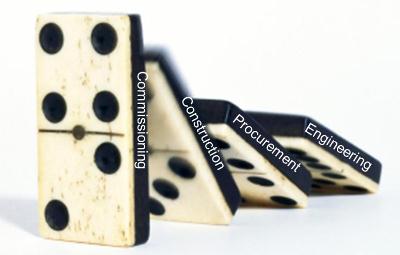How to easily estimate the duration of an Oil & Gas EPC Project
Did you know that Oil&Gas facilities projects have all the same critical path? Well, if you think about it, you will easily realize that what takes the most time in their completion is their piping.

Did you know that Piping is generally the critical path and that simple rules of thumb allow you to determine the duration of your project?
Thanks to a number of rule-of-thumb estimates that can be added to this observation, it is easy to deduct what is the duration of an EPC project in the Oil & Gas field, and what are the parameters that actually drive this duration. In the new, unique groundbreaking expert paper 2013-02, Hervé Baron reveals key fundamentals that will be useful to any Project Manager in Oil & Gas EPC projects.
Project managers and project planners too often dwell in too complicated approaches when it comes to determine project duration. The key is always to understand what is the chain of activities that actually will drive the project delivery. The paper proposes a uniquely elegant approach to project management for oil-and-gas projects using piping as the critical chain, and a number of extremely useful rules-of-thumb to determine the expected project duration.
The paper also includes a very well thought graphic illustration of the drivers of the project schedule and how they relate together on a timeline. Don’t miss our new expert paper 2013-02!
Hervé Baron is the author of “The Oil & Gas Engineering Guide” (Editions Technip). He conducts training in Engineering, Contract Management and Project Control. For more information and a number of additional useful resources please consult his blog: http://www.toblog.fr/fr/baron.html.










How Proper Project Risk Management Goes Against Common Management Thinking
Low probability, high consequence risks happen more often than we usually think and they are the ones that ultimately, shape a company or even an industry. Because they do not happen often, their prevention is easily overlooked and left to the next project. Yet, high risk industries like the nuclear or the aeronautics industry can teach us basic techniques and mindsets we can use to easily diminish the probability and the impact these risk. The project organizations that will implement these simple techniques will gain significantly in consistency of delivery and protect themselves against catastrophic events.
Our new White Paper 2013-04 “Project Risk Management Reloaded: How Proper Risk Management in Project Organizations Goes Against Common Management Thinking” tackles this important issue.
In project organizations, the worst that can happen is an organizational common cause of failure. The biggest challenge organizations face is how to effectively diversify their ways of doing things to avoid common causes of process failures. This goes against the tendency to seek maximum efficiency through standardization of tools and processes.
The point is that in today’s world in general, and even more in project organizations, efficiency of repeated production is not the key to success. Resilience to chaos or adaptation capability are the keys to success. If that goes with some loss of efficiency, so be it.
The biggest challenge organizations face is how to effectively diversify their ways of doing things to avoid common causes of process failures. This means, letting individual projects experiment with new ways of doing things, within certain limits; accept small failures to avoid a larger one that would wipe out the organization; and accept small failures to find better ways of doing things. Are you ready for that?
Read our White Paper 2013-04 “Project Risk Management Reloaded: How Proper Risk Management in Project Organizations Goes Against Common Management Thinking” why you need to change your approach to risk management today!